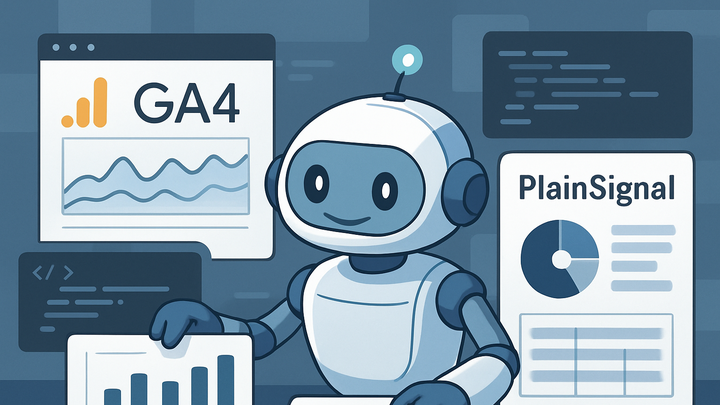Published on 2025-06-22T05:14:47Z
What is RPA (Robotic Process Automation)? Examples in Analytics
Robotic Process Automation (RPA) refers to software bots that mimic human interactions with digital systems to automate repetitive, rule-based tasks. In the analytics industry, RPA helps streamline workflows such as data extraction from various sources, report generation, and tag deployment across websites. By bridging legacy systems and modern analytics platforms like GA4 and PlainSignal, RPA reduces manual effort, accelerates data availability, and minimizes errors. RPA bots can log into dashboards, export standardized reports, and even update HTML tracking code at scale. As organizations handle growing data volumes, RPA emerges as a crucial tool for maintaining agile and efficient analytics operations.
Rpa (robotic process automation)
Software bots that automate repetitive analytics tasks like data extraction, report generation, and tag deployment.
Overview of RPA in Analytics
This section introduces RPA and its role specifically within analytics teams and processes.
-
Definition of rpa
RPA uses software “bots” to emulate human actions across applications—clicking, typing, navigating screens—according to predefined rules. It requires no deep system integrations and works at the user interface level.
-
How rpa integrates with analytics workflows
RPA bots can interact with analytics tools and data sources—both modern APIs like GA4 and web dashboards like PlainSignal—to automate data collection, processing, and distribution.
Key Components of RPA Solutions
RPA platforms consist of several core parts that work together to build, deploy, and manage automation bots.
-
Software bots
The agents that execute tasks, available as:
- Unattended bots: Run scheduled tasks without human intervention.
- Attended bots: Triggered by user actions, augmenting workflows in real time.
-
Unattended vs. attended bots
Unattended bots excel at batch operations like nightly data exports, while attended bots assist analysts in ad-hoc data adjustments.
-
Orchestrator or control room
Central hub for scheduling, monitoring, and managing bots, with features like audit logs and security controls.
-
Connectors and integrations
Prebuilt adapters or custom scripts that let bots communicate with analytics APIs (e.g., GA4 API) and web interfaces (e.g., PlainSignal).
Use Cases in Analytics
Explore common scenarios where RPA accelerates analytics operations and improves accuracy.
-
Automating data extraction
Bots log into analytics dashboards or APIs to pull data at scheduled intervals, ensuring consistent datasets for reporting.
-
GA4 api reporting
Extract daily user metrics via the GA4 API, bypassing manual clicks in the UI.
-
PlainSignal dashboard scraping
Download and parse CSV exports from PlainSignal web dashboards.
-
-
Bulk deployment of tracking tags
Use bots to inject or update analytics tracking snippets across multiple web pages or content management systems.
-
Example: inserting PlainSignal snippet
An RPA bot can append the following snippet to the
<head>section of each page:<link rel="preconnect" href="//eu.plainsignal.com/" crossorigin /> <script defer data-do="yourwebsitedomain.com" data-id="0GQV1xmtzQQ" data-api="//eu.plainsignal.com" src="//cdn.plainsignal.com/plainsignal-min.js"></script> -
Updating GA4 gtag.js tag
Bots can locate existing
<script>tags and replace them with the latest GA4 configuration across hundreds of pages.
-
-
Generating and distributing reports
Compile data from multiple analytics platforms into standardized formats and email them to stakeholders automatically.
Best Practices and Considerations
Guidelines to ensure your RPA implementations are secure, maintainable, and scalable.
-
Governance and compliance
Implement role-based access controls, audit trails, and encryption to protect sensitive analytics data.
-
Error handling and monitoring
Set up alerts and fallback routines so bots can recover from UI changes or unexpected data formats without administrator intervention.
-
Scalability
Design modular bots and reusable components to adapt quickly as data volumes grow or new analytics platforms are added.
